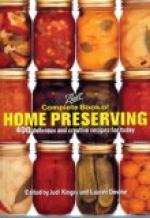TIDYING UP AND SPRINKLING
The last article being hung on the line, each implement used in the process of washing must be cleaned, dried, and put in its place, the laundry floor scrubbed, and everything made spick and span; then comes the sprinkling and rolling of the piles of snowy, sweet-smelling linen, all full of fresh air and sunshine, to make a little rest time after the vigorous exercise which precedes it. It must be done with care as much depends upon it. Table linen, unless taken from the line while still moist, should be sprinkled very damp, folded evenly, rolled and wrapped in a white cloth, and placed in the clothes basket, which has been previously lined with an old sheet. Bed linen and towels require very little dampening; they, too, to be rolled and placed with the table linen. Sprinkle body linen well, particularly the lace and embroidery trimmings, roll tight, wrap, and add to the growing pile in the basket. The kitchen towels which have just come from the line may be utilized for wrapping purposes. Handkerchiefs receive the same treatment as napkins in sprinkling, folding, and ironing. Although everything irons more easily after being rolled for some time, thus evenly distributing the dampness, an exception must be made of colored clothing, which must not be sprinkled more than half an hour before it is ironed. When the sprinkling is all done, cover the basket with a damp cloth, then with a dry one, and leave till ironing time. If a coal range is in use, see that the fire is burning steadily, replenishing from time to time, first on one side, then on the other, brush off the top of the stove, wipe the irons, and put on to heat. If they heat slowly, invert a large dish pan over them.
CARE OF IRONS
When not in use, irons can be protected from dampness and resulting rust by covering with mutton fat or paraffine, rubbed on while slightly warm. It is easily removed when the irons are wanted for use. Rust spots can be removed by applying olive oil, leaving for a few days, and then rubbing over with unslaked lime. Scrub with soap and water, rinse, dry, rub with beeswax, and wipe off with a clean cloth. The soap and water treatment, followed by a vigorous rubbing on brick-dust, should be given frequently, irrespective of rust. Irons must neither be allowed to become red-hot nor to stand on the range between usings, or roughness will result. When not in use, stand on end on a shelf. Rubbing first with beeswax and then with a clean cloth will prevent the irons from sticking to the starched things.




